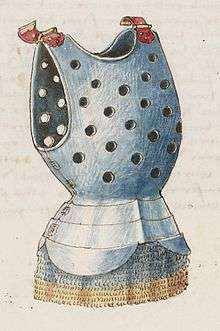Mail coif
A mail coif is a type of armour which covered the head. A mail coif was a flexible hood of chain mail that extended to cover the throat, neck and the top part of the shoulders. They were popular with European fighting men of the Middle Ages.
_cropped.jpg)
History
The coif dates from the 10th century, and is a close fitting cap that covers the top, back, and sides of the head. It was usually made from white linen and tied under the chin. They were everyday wear for lower-class men and women from the 12th to 15th centuries.[1]
Mail originated with the Celts in the 5th century BC.[2] After the destruction of the Thracians by the Roman Empire, the mail came back into fashion as the most common form of battlefield armour much later, during the Middle Ages among European mounted and foot soldiers until the 13th century.[3]
Construction

The most common pattern of linking the rings together is the 4-to-1 pattern, where each ring is linked with four others. Historically, the rings composing a piece of mail would be riveted closed to reduce the chance of the rings splitting open when subjected to an attack. In the beginning, European mail was made of alternating rows of round riveted rings and solid rings. By the 14th century, European mail makers stopped using solid rings and mail was made from wedge riveted rings only with no solid rings.[4]
By the late 15th century, the aventail had replaced the mail coif completely. An aventail is a curtain of mail which is attached to the skull of a helmet. The mail extends to cover the throat, neck and shoulders.
For the word mail, there are a variety of alternative spellings. This is common of an English word introduced from the French. Generally, the English spelling has been preferred, which is mail, instead of the lately used maille or the inauthentic term chainmail.
See also
- Mail (armour)
- Components of medieval armour
- Coif
- Aventail
- Hauberk
References
- Leventon 2008, p. 321.
- Webber 2011.
- Leventon 2008, p. 48.
- Richardson 2011, p. 304.
Bibliography
- Gabriel, Richard A. (2007), The Ancient World, Greenwood Publishing Group
- Leventon, Melissa (2008), What People Wore When – A Complete Illustrated History of Costume from Ancient Times to the Nineteenth Century for Every Level of Society, St Martin’s Griffin, New York: The Ivy Press Limited
- Richardson, T. (2011), "Armour in England, 1325–99", Journal of Medieval History, 37 (3): 304–320, doi:10.1016/j.jmedhist.2011.06.001.
- Webber, Christopher (2011), The gods of battle : the Thracians at war, 1500 BC - AD 150, Barnsley, South Yorkshire: Pen & Sword Military, ISBN 978-1-84415-835-5
